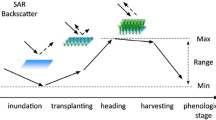Abstract
Because of the cloudy conditions during the rice growth period, rice is one of the agricultural crops most suited to monitoring with the SAR instruments. Backscatter response measured by SAR is correlated with rice conditions, including height, density, biomass and structure, which are variable at different growing stages. In this paper, multi-date ENVISAT ASAR Alternating Polarization Mode (APMode) imageries were acquired during the rice crop growing cycle. At the same time, the rice parameters were measured in field. A continuous canopy model was used to compute the backscattering from rice fields during the growth cycle, and the relationship between rice parameters and radar backscattering coefficients from both ASAR and modeling was analyzed. The effects of polarization, incidence angle and polarization on radar backscattering coefficients were analyzed. It was found that simulated radar backscatter has similar trends as ASAR data. This will be meaningful for the further research of rice parameters estimation from ASAR data. Different features show significantly different signatures in ASAR images and they follow some certain laws, so rice area can be accurately mapped by using multi-temporal SAR images, then rice yield can be estimated.
Similar content being viewed by others
References
Holecz F, Dwyer E, Monaco S, et al. An operational rice field mapping tool using spaceborne SAR data. ERS-ENVISAT Symposium, Göteborg, October. 2000
Thuy L T, Florence R, Wang L F, et al. Rice crop mapping and monitoring using ERS-1 data based on experiment and modeling results. IEEE Trans Geosci Remote Sensing, 1997, 35(1): 41–56
Brakke T W, Kanemasu E T, Steiner J L, et al. Microwave radar response to canopy moisture, Leaf-Area Indx, and dry weight of wheat, corn and sorghum. Remote Sensing Environ, 1981, 11: 207–220
Cloutis E A, Connery D R, Dover F J. Agricultural crop monitoring using airborne multi-spectral imagery and C-band synthetic aperture radar. Int J Remote Sensing, 1999, 20(4): 767–787
Mcnairn H, Ellis J, Van Der Sanden J J, et al. Providing crop information using RADARSAT-1 and satellite optical imagery. Int J Remote Sensing, 2002, 23(5): 851–870
Takashi K, Masaharu F, Kazuo C. Monitoring of rice crop growth from space using the ERS-1 C-band SAR. IEEE Trans Geosci Remote Sensing, 1995, 33(4): 1093–1096
Thuy L T, Henri L, Eric M, et al. Multitemporal and dural-polarization observations of agricultural aegetation aovers by X-band SAR Images. IEEE Trans Geosci Remote Sensing, 1989, 27(6): 709–718
Shao Y, Fan X T, Liu H, et al. Rice monitoring and production estimation using multitemporal RADARSAT. Remote Sensing Environ, 2001, 76: 310–325
Shao Y, Liao J J, Wang C Z. Analysis of temporal radar backscatter of rice: a comparison of SAR observations with modelling results. Can J Remote Sensing, 2002, 28(2): 128–138
Inoue Y, Kurosu T, Maeno H, et al. Season-long daily measurements of multifrequency (Ka, Ku, X, C, and L) and full-polarization backscatter signatures over paddy rice field and their relationship with biological variables. Remote Sensing Environ, 2002, 81: 194–204
Zeng Q M, Ma H B, Zhang T. Study and computing of rice backscattering coefficients. Acta Sci Nat Univ Pek (in Chinese), 2000, 36(1): 131–141
Sun G Q, Simonett D S. A composite L-band radar backscattering model for coniferous forest stands. Photogram Eng Remote Sensing, 1988, 54(8): 1195–1201
Fawwaz T U, Richard K M, Adrian K F. Microwave Remote Sensing-Active and Passive, Volume III, Michigan: Aztech House, 1986. 1087–1088
Ulaby F T, Sarabandi K, Mcdonald K, et al. Michigan microwave canopy scattering model. Int J Remote Sensing, 1990, 11: 1223–1253
Karam M A, Fung A K, Lang R H, et al. A microwave scattering model for layered vegetation. IEEE Trans Geosci Remote Sensing, 1992, 30: 764–784
Bracaglia M, Ferrazzoli P, Guerriero L. A fully polarimetric multiple scattering for crops. Remote Sensing Environ, 1995, 54: 170–179
Fung A K, Microwave Scattering and Emission Models and Their Applications, London: Artech House, 1994
Sun G Q, David S S. Simulation of L-band HH microwave backscattering from coniferous forest stands: a comparison with SIR-B cata. Int J Remote Sensing, 1988, 9(5): 907–925
Fawwaz T U, Mohamed A. El-rayes. Microwave dielectric spectrum of vegetation-part II: dual-dispersion model. IEEE Trans Geosci Remote Sensing, 1987, GE-25(5): 541–549
Author information
Authors and Affiliations
Corresponding author
Rights and permissions
About this article
Cite this article
Dong, Y., Sun, G. & Pang, Y. Monitoring of rice crop using ENVISAT ASAR data. SCI CHINA SER D 49, 755–763 (2006). https://doi.org/10.1007/s11430-006-0755-0
Received:
Accepted:
Issue Date:
DOI: https://doi.org/10.1007/s11430-006-0755-0




